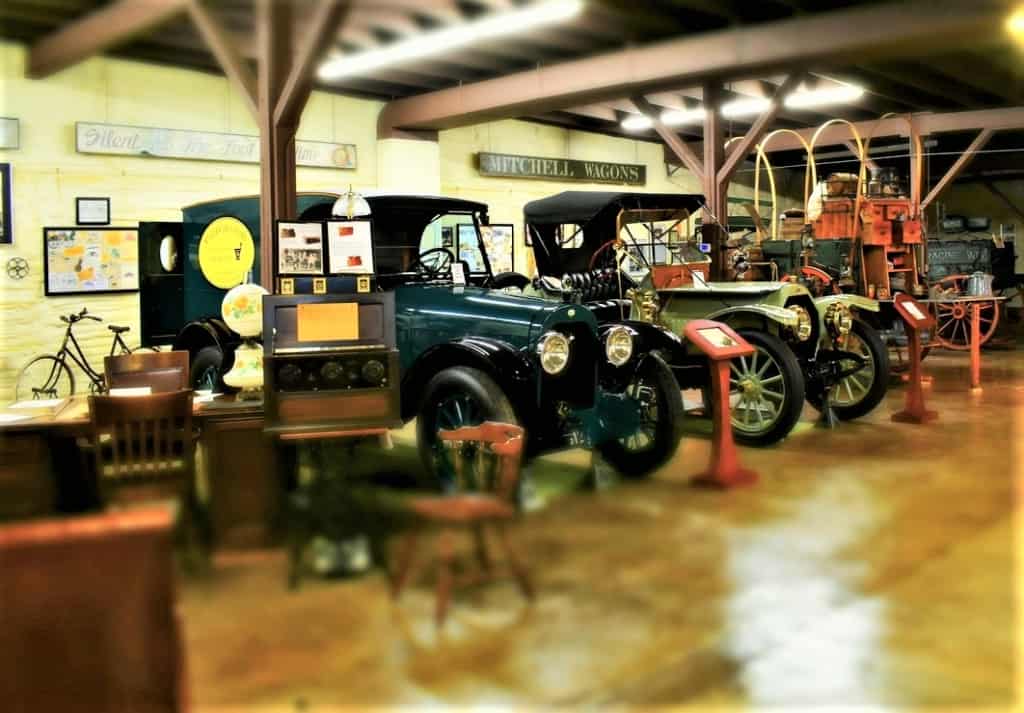When we think about travel at the turn of the 19th Century, everything seemed so black and white. Much of that is because color photography had not yet been invented. Of course, from visiting museums, we also realize that many of the automobiles of the day were produced in one color. Until our visit to the Mitchell Car Museum, we didn’t know there were so many wonderful colors to choose from in those days. Our trip to Boonville, Missouri offered us a chance to see some of these beautiful machines up close.

An Early Start
You have to head back to the early 1800s to get to the beginning of this story. Over in Edinburgh, Henry Mitchell was working at a local wagon shop. After getting married, Henry and his wife, Margaret, sailed to America. Here he would take on a partner and proceed to open Mitchell Wagon Works. They produced some of the earliest wagons in Chicago. A few years later, he would move again, and this time land in Southport, Wisconsin. We learned this was a previous name for Kenosha, during our visit to the city along the lakeshore. Over time, the Mitchell family would grow and more would become engaged in the business.

Delivering the Goods
After the Civil War, William Lewis joined the business, after marrying into the family. Lewis bought into the company and the two of them established H. Mitchell & Co. The family business flourished and grew to the point of producing 8 to 10 thousand wagons per year. In 1880, disaster struck when the wagon factory burned to the ground. While many businesses would have been devastated, not so for this one. They not only regained their market share but became a leading world exporter of wagons around the world.

Next Steps
Much like today, the technology of the times was moving forward, as we saw at the Mitchell Car Museum. Mitchell and Lewis capitalized on these advancements by introducing a motorized bicycle at the tail end of the 1800s. When you think of today’s motorcycles, these early models paled in comparison. Many of the motorized versions were no faster than peddle-powered bicycles. Still, the lessons learned with each new model would move technology forward. In 1902, Mitchell Motor Cycle was outpacing its competitor Harley-Davidson with a whopping 600 motorcycles.

Moving Forward
Besides outpacing Harley-Davidson, there was another notable event in 1902. That was the year that Mitchell and Lewis introduced their first automobile. The following year they established the Mitchell Motor Car Company, which signified the move from wagons to autos. They started with two models that offered customers a choice between 4 or 7 horsepower motors. By 1904, they had streamlined their assembly process to the point that they built 82 new automobiles. The lessons they learned from the wagon industry helped them to establish themselves as an international car manufacturer. Soon they were selling Mitchell cars on nearly every continent.

Into the Blue
One of the things that caught our eye was the beautiful colors that we saw lined up in the museum. After visiting a slew of museums, we have seen a variety of cars from the turn of the century. Most auto manufacturers seemed satisfied with sticking to black as their main offering, but not Mitchell. They had a range of colors to choose from, with blue being their most recognizable. We have to say that when combined with all of the brass accents, it makes for a striking appearance. For this visit, our tour guide was Katie Gibson, who serves as Tourism Director for the City of Boonville. She pointed out that Mitchell was ahead of the pack by choosing to offer customers a higher-end product produced in an array of colors.

Coloring the Past
The Mitchell Car Museum holds a wonderful assortment of models from the company’s history. Their ability to produce a consistently superior product pushed them forward in the marketplace. By 1910, the Mitchell Motor Car Company had just under 3000 employees and was producing over 5600 automobiles. New advancements were coming almost every year. Soon the gas lamps would be replaced with electric lights. Hand-crank starters would be updated to self-starting devices.

Beauty Show
The company continued to prosper under the family’s guidance. In 1916, the company sold around 10,000 vehicles, but the family was reeling from the loss of its founder the previous year. Tiring of the day-to-day details, the family sold their interest in the business to investors from New York and Chicago. This would signify the end of an era for the Mitchell Motor Car Company. 1917 saw the world plunged into war, which had severe implications for the economy. The government had contracted with the company for four-wheel-drive trucks to be used in the war effort. Still, the company was able to produce multiple body styles at the same time.

Taking In the Mitchell Car Museum
As Katie led us through the Mitchell Car Museum, we were in awe of the beauty of these vehicles. The collection is in the care of Lewis Miller, who is a descendant of the original owners. His Mitchell collection is certainly unique and allows others to have a peek into the past. Most of the machines have been meticulously revived by Lewis. He is owner, operator, and caretaker of the Mitchell Car Museum and his love for these vehicles is obvious. Over the past couple of decades, he and his wife, Susan, have amassed the most extensive collection of Mitchell vehicles in the world.

Projects in the Works
As we were finishing up our tour, Katie had one more surprise for us. In a nearby garage bay, Lewis has another project in the works. Here we could see all of the detailed work required to reboot one of these vehicles into pristine shape. It obviously requires a lot more than a wash and wax. This 1914 Mitchell Touring Car needed plenty of loving care, as well as some new cast replacement parts. We can only imagine the cost associated with keeping all of these antique machines in running order.






What an impressive collections of antique cars to check out here, what vivid colors some of these cars have. Love seeing all the gorgeous details and craftsmanship
They are some amazing creations.
What a find you have here. The Mitchell’s were certainly great manufacturers with thousands of wagons, more motorcycles than Harley Davidson, and then the stylish colorful automobiles. Great Lewis keeps the legacy going.
The number of products that they were able to turn out was staggering. Especially when you consider the age of automation had not really materialized.
Those old cars look lovely. But I suspect that they were rather uncomfortable to ride in, and probably very cold as well!
Surely, and the roads were probably quite the challenge to navigate.
The Mitchell Car Museum sounds like a must when visiting Boonville, Missouri. It also seems unusual in that it specializes in magnificent “old-timers.”
It is definitely a place to visit when in Boonville.
Beautiful Autos Jeff & Crystal. Having lived in Racine until retirement, I can attest to a number of manufacturing facilities within 25 miles. Mitchell, Massey-Harris, Bodies made for Hupmobiles, Rambler, Nash, J.I. Case, Wallis Tractors, Allis Chalmers, and of course Harley-Davidson. If I get near Boonville I’ll certainly stop by. Keep up the good work.
If you ever get to Milwaukee, take in the Harley Museum, it’s worth the time!
We are glad you enjoyed the article. Thanks for the tip on the stop in Milwaukee. We’ll keep it in mind.